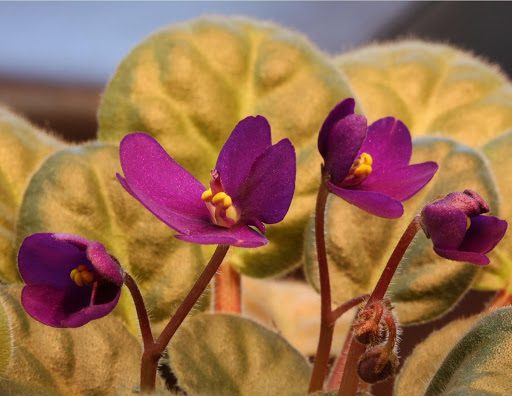Want to become a plant psychic? It’s simple. Learn the language of their leaves. Changes to your plant’s foliage are often the first indication that something’s not right. The delicate African violet is no exception.
One common symptom—leaves beginning to curl—is particularly perplexing. That’s because slight variances in the ailment can signify very different issues with your plant. Luckily, they’re all pretty simple fixes. Let’s take a look at the different ways African violet leaves curl, and what your plant is telling you.
Why African Violet Leaves Curl Upwards
Is your African violet shooting for the stars? Normally, we love an overachiever. But if your plant starts to stretch out and reach upward, it’s asking for a change of scenery.
What it Looks Like
- Healthy African violet leaves hug the soil surface. But instead, your plant’s leaves are growing long and spindly. The stems are clearly visible, rather than being tucked beneath the foliage.
- Instead of growing flat and full, your African violet leaves curl upwards, bowing in on themselves.
- The stem of your plant is exposed because there are no leaves near the soil surface; your plant is top-heavy and looks like it could tip over.
- Normally lush and full leaves become thin and darker green.
What it Means
Let there be light! When your African violet shows these symptoms, it is literally reaching for more light. This often happens when thoughtful caretakers are trying to protect the sensitive plant from direct sunlight. Bright, indirect sunlight, however, is critical to your plant’s health. It’s time to move your plant to a better-lit place; it will only grow weaker and withhold its blooms where it’s at.
Why African Violet Leaves Curl Inwards
Perhaps you’ve noticed the opposite problem: your African violet’s leaves are curling inwards.
Some varieties do this naturally, so it’s important to know how your plant appears when healthy. In other varieties, leaves curling inwards are a sign your plant is struggling. Here’s what you might see.
What it Looks Like
- The leaves become slightly accordioned at the edges and begin to curl inwards.
- New leaves begin to grow tightly bunched or huddled together.
- The velvety layer on the leaves has become thicker than usual.
- Rather than full and supple, your African violet leaves are brittle and frail.
What it Means
Turn up the heat! The symptoms above indicate that your plant is chilling, and not in a fun way. African violets are tropical natives and are happiest around 70 degrees Fahrenheit. The remedy is simple: move your plant to a warmer place.
Houseplant Pro Tip: The same symptoms can be caused by watering your plant with too-cold water. Always use room-temperature or even slightly tepid water to nourish your plant. Check out our Guide to Watering African Violets for the full scoop.
Why African Violet Leaves Droop and Curl
Uh oh! Your plant is pouting, and you don’t know what you’ve done. African violet leaves can curl and droop, becoming limp and dull. This might be alarming, but it’s usually a pretty easy fix.
What it Looks Like
- Your plant’s full, vigorous leaves have become soft and limp. The edges sag and curl inwards.
- Your African violet leaves have lost their vibrancy and have become dull and faded.
- The veins on the leaves begin to pucker up.
- Your plant’s topsoil is dry and crumbly to the touch.
- The leaves may be brown and brittle around the edges.
What It Means
Bottoms up! Usually, this is a sign that your African violet is in need of a drink. Press your finger knuckle-deep in the topsoil. If it feels bone dry and only a few pieces of dirt stick to your finger, it’s time to water your plant. A houseplant moisture meter is another useful tool to ensure your plant never goes thirsty.
Houseplant Pro Tip: Be careful! African violets are persnickety bathers. 1) Don’t over-water or excessively swamp the soil. 2) Use room-temperature water. 3) Keep the plant’s delicate leaves dry. (They can burn when exposed to the sun!)
Other Common African Violet Leaf Problems
There are many ways your plant communicates with you through its leaves. Other than the common symptoms listed above, the following signs are your African violet’s way of hinting it needs a little TLC.
- Lower leaves wilting: When lower leaves wilt and turn mushy (not to be confused with natural decay), your plant has problems underground. It’s time to check for root rot. Here’s how:
- Gently remove your plant from the pot and brush away the soil.
- Examine the roots and cut away any sections that are black, brown, or mushy.
- Consider treating with root rot treatment.
- Repot in well-draining potting mix and water, taking care to not overdo it.
- Late-stage root rot is hard to remedy, but your plant can recover if you catch the symptoms early on.
- Pale or bleached leaves: This indicates your African violet’s leaves are struggling under the harsh rays of the sun. Transfer to a well-lit area away from heat and direct sunlight, and your plant will be much happier.





